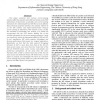Free Online Productivity Tools
i2Speak
i2Symbol
i2OCR
iTex2Img
iWeb2Print
iWeb2Shot
i2Type
iPdf2Split
iPdf2Merge
i2Bopomofo
i2Arabic
i2Style
i2Image
i2PDF
iLatex2Rtf
Sci2ools
LCN
2006
IEEE
2006
IEEE
Merit of PHY-MAC Cross-Layer Carrier Sensing: A MAC-Address-based Physical Carrier Sensing Scheme for Solving Hidden-Node and Ex
This paper examines how various carrier-sensing schemes affect the exposed-node (EN) and hidden-node (HN) phenomena. In the process, we identify a new carrier-sensing mechanism for alleviating EN and HN that is more effective than previously proposed schemes. This scheme, referred to as the MP scheme, uses MAC-address-based Physical carrier sensing to determine if the medium is busy. In MP, the addresses of transmitter and receiver of a packet are incorporated into the PHY header. Making use of this address information for its carrier-sensing operation, a node can drastically reduce the detrimental effects of EN and HN. In ns2 simulations, MP yields superior throughput and fairness performance that exceed our original expectation. Specifically, we find that the total network throughput achieved by MP is more than twice that of the 802.11b basic-access mode, and more than four times that of the 802.11b RTS/CTS mode, under various node-density and packet-size assumptions. At the same ti...
| Added | 12 Jun 2010 |
| Updated | 12 Jun 2010 |
| Type | Conference |
| Year | 2006 |
| Where | LCN |
| Authors | An Chan, Soung Chang Liew |
Comments (0)

